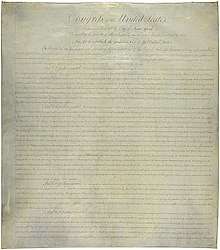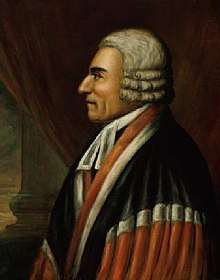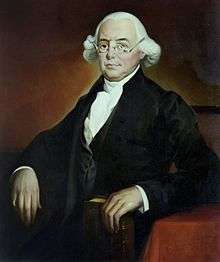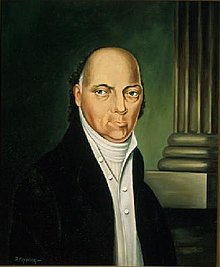Judiciary Act of 1789
The Judiciary Act of 1789 (ch. 20, 1 Stat. 73) was a United States federal statute adopted on September 24, 1789, in the first session of the First United States Congress. It established the federal judiciary of the United States.[2][3][4][5] Article III, Section 1 of the Constitution prescribed that the "judicial power of the United States, shall be vested in one Supreme Court, and such inferior Courts" as Congress saw fit to establish. It made no provision for the composition or procedures of any of the courts, leaving this to Congress to decide.[6]
.svg.png) | |
| Long title | An Act to establish the Judicial Courts of the United States |
|---|---|
| Nicknames | establishment of the federal judiciary |
| Enacted by | the 1st United States Congress |
| Citations | |
| Statutes at Large | 1 Stat. 73 |
| Legislative history | |
| |
| Major amendments | |
| Judiciary Act of 1801, 1802, 1866, 1867, 1869, 1891, 1925 U.S. Const. amend. XI | |
| United States Supreme Court cases | |
| Marbury v. Madison | |
The existence of a separate federal judiciary had been controversial during the debates over the ratification of the Constitution. Anti-Federalists had denounced the judicial power as a potential instrument of national tyranny. Indeed, of the ten amendments that eventually became the Bill of Rights, five (the fourth through the eighth) dealt primarily with judicial proceedings. Even after ratification, some opponents of a strong judiciary urged that the federal court system be limited to a Supreme Court and perhaps local admiralty judges. The Congress, however, decided to establish a system of federal trial courts with broader jurisdiction, thereby creating an arm for enforcement of national laws within each state.
Legislative history
Senator Richard Henry Lee (AA-Virginia) reported the judiciary bill out of committee on June 12, 1789;[1] Oliver Ellsworth of Connecticut was its chief author.[7] The bill passed the Senate 14–6 on July 17, 1789, and the House of Representatives then debated the bill in July and August 1789. The House passed an amended bill 37–16 on September 17, 1789. The Senate struck four of the House amendments and approved the remaining provisions on September 19, 1789. The House passed the Senate's final version of the bill on September 21, 1789. U.S. President George Washington signed the Act into law on September 24, 1789.[2]
Provisions of the Act

The Act set the number of Supreme Court justices at six: one Chief Justice and five Associate Justices.[8] The Supreme Court was given exclusive original jurisdiction over all civil actions between states, or between a state and the United States, as well as over all suits and proceedings brought against ambassadors and other diplomatic personnel; and original, but not exclusive, jurisdiction over all other cases in which a state was a party and any cases brought by an ambassador. The Court was given appellate jurisdiction over decisions of the federal circuit courts as well as decisions by state courts holding invalid any statute or treaty of the United States; or holding valid any state law or practice that was challenged as being inconsistent with the federal constitution, treaties, or laws; or rejecting any claim made by a party under a provision of the federal constitution, treaties, or laws.[1]
SECTION 1. Be it enacted by the Senate and House of Representatives of the United States of America in Congress assembled, That the supreme court of the United States shall consist of a chief justice and five associate justices, any four of whom shall be a quorum, and shall hold annually at the seat of government two sessions, the one commencing the first Monday of February, and the other the first Monday of August. (bold added)
— Judiciary Act of 1789
The Act also created 13 judicial districts within the 11 states that had then ratified the Constitution (North Carolina and Rhode Island were added as judicial districts in 1790, and other states as they were admitted to the Union). Each state comprised one district, except for Virginia and Massachusetts, each of which comprised two. Massachusetts was divided into the District of Maine (which was then part of Massachusetts) and the District of Massachusetts (which covered modern-day Massachusetts). Virginia was divided into the District of Kentucky (which was then part of Virginia) and the District of Virginia (which covered modern-day West Virginia and Virginia).[1]
This Act established a circuit court and district court in each judicial district (except in Maine and Kentucky, where the district courts exercised much of the jurisdiction of the circuit courts). The circuit courts, which comprised a district judge and (initially) two Supreme Court justices "riding circuit," had original jurisdiction over serious crimes and civil cases of at least $500 involving diversity jurisdiction or the United States as plaintiff in common law and equity. The circuit courts also had appellate jurisdiction over the district courts. The single-judge district courts had jurisdiction primarily over admiralty cases, petty crimes, and suits by the United States for at least $100. Notably, the federal trial courts had not yet received original federal question jurisdiction.
Congress authorized all people to either represent themselves or to be represented by another person. The Act did not prohibit paying a representative to appear in court.
Congress authorized persons who were sued by citizens of another state, in the courts of the plaintiff's home state, to remove the lawsuit to the federal circuit court. The power of removal, and the Supreme Court's power to review state court decisions where federal law was at issue, established that the federal judicial power would be superior to that of the states.
The Act created the Office of Attorney General, whose primary responsibility was to represent the United States before the Supreme Court. The Act also created a United States Attorney and a United States Marshal for each judicial district.[5]
The Judiciary Act of 1789 included the Alien Tort Statute, now codified as 28 U.S.C. § 1350, which provides jurisdiction in the district courts over lawsuits by aliens for torts in violation of the law of nations or treaties of the United States.[9]
Implementation
Immediately after signing the Judiciary Act into law, President Washington submitted his nominations to fill the offices created by the Act. Among the nominees were John Jay for Chief Justice of the United States; John Rutledge, William Cushing, Robert H. Harrison, James Wilson, and John Blair Jr. as Associate Justices; Edmund Randolph for Attorney General; and myriad district judges, United States Attorneys, and United States Marshals for Connecticut, Delaware, Georgia, Kentucky, Maryland, Maine, Massachusetts, New Hampshire, New Jersey, New York, Pennsylvania, South Carolina, and Virginia.[1][10] All six of Washington's Supreme Court nominees were confirmed by the Senate. Harrison, however, declined to serve. In his place, Washington later nominated James Iredell, who joined the Court in 1790, thereby bringing the Court to its "full strength" complement of six members.
First justices of the Supreme Court
The first six persons to serve on the United States Supreme Court (ordered by seniority) were:
.jpg) John Jay
John Jay
Chief Justice William Cushing
William Cushing
Associate Justice
 James Wilson
James Wilson
Associate Justice John Blair
John Blair
Associate Justice James Iredell
James Iredell
Associate Justice
Judicial review
A clause in Section 13 of the Judiciary Act, which granted the Supreme Court the power to issue writs of mandamus under its original jurisdiction, was later declared unconstitutional. In Marbury v. Madison,[11] one of the seminal cases in American law, the Supreme Court held that was unconstitutional because it purported to enlarge the original jurisdiction of the Supreme Court beyond that permitted by the Constitution. The case was the first that clearly established that the judiciary can and must interpret what the Constitution permits and invalidate laws which are contrary to the Constitution. Thus, the Judiciary Act of 1789 was the first act of Congress to be partially invalidated by the Supreme Court.[12][13]
See also
- List of federal judges appointed by George Washington
- List of courts of the United States
- United States Constitution
References
- Marcus, Maeva (1992). The Documentary History of the Supreme Court of the United States, 1789–1800. Columbia University Press. ISBN 0-231-08867-1. Archived from the original on December 16, 2008. Retrieved July 15, 2013.
- "Judiciary Act of 1789". Library of Congress. Retrieved September 23, 2018.
- "History of the Federal Judiciary". Federal Judicial Center. Retrieved July 14, 2013.
- "1789 Judiciary Act". Encyclopædia Britannica. Retrieved July 14, 2013.
- "U.S. Marshals Service, History, The Judiciary Act of 1789". United States Marshals Service. Retrieved July 14, 2013.
- "Federal Judiciary Act (1789)". National Archives and Records Administration. Retrieved July 14, 2013.
- "Senator Ellsworth's Judiciary Act". United States Senate. Retrieved July 14, 2013.
- "Landmark Legislation: Judiciary Act of 1789". Federal Judicial Center.
- "28 USC § 1350 – Alien's action for tort | LII / Legal Information Institute". Law.cornell.edu. Retrieved June 22, 2012.
- "A Century of Lawmaking for a New Nation: U.S. Congressional Documents and Debates, 1774–1875". memory.loc.gov.
- Marbury v. Madison, 5 U.S. (1 Cranch) 137 (1803).
- Supreme Court History: The Court and Democracy, Marbury v. Madison, pbs.org, retrieved February 12, 2007
- Warren, Charles (September 24, 2018). The Supreme Court in United States History. Little, Brown. p. 222 – via Internet Archive.
as soon as the republicans passed their act.
External links
| Wikisource has original text related to this article: |
